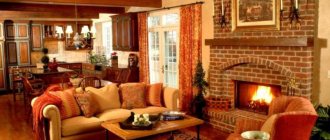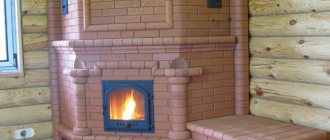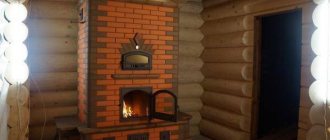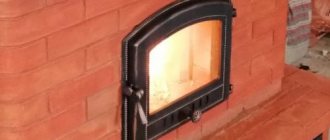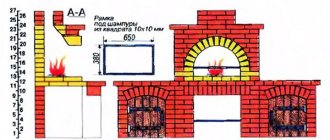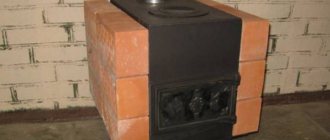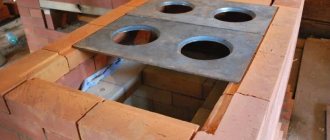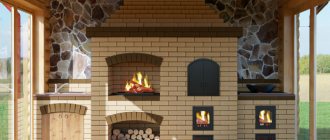The stove is a truly unique thing. It serves to heat the house, cook food in it, and in the past it was often used as a sleeping place. The fireplace has its own functional responsibilities.
The fireplace stove combines the advantages of both designs. Essentially, it is a fireplace and stove located on a common foundation and having one pipe system. The design is compact and multifunctional. The fireplace is convenient because it heats up the room quickly, while the stove accumulates heat and then releases it for a long time.
What is the difference between a Dutch woman and a Swedish woman, I confuse them
The Dutch oven was created specifically as a heating stove, but now they are making a hob in it. This device is much simpler than a Russian stove: a combustion chamber with a labyrinth of smoke ducts on top. The smoke travels along this winding path for a long time, and thanks to this the heat does not escape. In our country, Dutch was traditionally decorated with tiles - this option is considered a classic.
The Swedish stove is an improved version of the Dutch stove with a vertical system of smoke circulation channels. Swedish scientists optimized it in the mid-18th century by expanding the lower part and adding an oven to the side.
The Swedish oven is the result of careful calculations. With its quite compact size, it warms up quickly, allowing you to cook food, heat the house, etc. The efficiency of the Swedish stove is slightly inferior to that of the Russian stove, but this design requires precise calculations. They drown the Swede twice a day.
Required tools and materials
To make a brick fireplace stove yourself, you need to prepare the following materials:
- Heat-resistant brick - its quantity is determined by the size of the object. An average design will require approximately 800 pieces.
- Heat-resistant mixture - it is made on the basis of clay or oven glue.
- Doors with fireproof glass.
- Doors for the firebox and vent holes.
- Cooking plates.
- Materials for thermal insulation.
- Steel angles, plates, sheets.
- Wire.
- Double pipes and chimney openings.
- Cement, sand, crushed stone.
- Heat-resistant floor covering.
The list of necessary equipment and materials may vary depending on the drawing and final appearance of the entire heating facility.
Can a fireplace be installed in any room of the house or are there restrictions?
There are a lot of restrictions. It is not allowed on the second floor (usually the ceilings are not designed to support the weight of even a small fireplace), in a regularly shaped room with an area of at least 20 square meters with three-meter ceilings, so that the volume of air is sufficient for normal combustion. But a fireplace that is too small will not be able to heat a large room. For masonry fireplaces there is a rule:
area of the combustion window = 1/50 of the area of the room.
The firebox window should “look” into the middle of the room.
Kinds
Each type of fireplace has its own distinctive features.
Rectangular
A structure with dimensions of 5×2.5, which does not have a door on the firebox. Refractory bricks are laid in 33 rows, which should not crack at temperatures above 1100°.
Excellent draft is achieved by creating a through channel that removes smoke.
To better heat the room, empty channels are built along the firebox and chimney.
On the website you can use a ready-made diagram with the necessary calculations. The falling chips cut off. To check the correctness of the form, use a building level.
Angular
The sketch is also available on the Internet. An extremely convenient model built into a corner.
Due to the lack of oxygen to heat the room, it is better to place them where the area is no more than 12 m2.
It is assumed that the installation will be carried out by a mason of at least 5th grade, since such a task cannot be done without certain knowledge and skills. It should be remembered that the internal structure of all fireplaces is similar, as is the flame of the fire in the firebox.
The advantage of this type is its compactness and uniform distribution of energy throughout the living space. Having a wonderful decorative effect, it once again reminds of the status of the owner.
The only thing that can stop you from installing it is the significant financial costs for finishing. High quality bricks are used, marked at least M200.
A layer of thermal insulation is placed between the wall and the future fireplace or a 1/4 brick is laid on the edge with wire for reinforcement.
Miniature
Designed for small spaces of 16 m2. Placed in a partition to heat 2 rooms.
For greater heat transfer, the firebox is laid out without refractory bricks. Ceramic heats up faster, consuming the temperature of the array.
If you lack qualifications when performing the work, the portal arch can be replaced with a horizontal ceiling by purchasing 2 metal corners of the required length in advance. Construction will significantly save money.
English
Not very bulky in appearance, this type of fireplace has been used since ancient times. A pronounced classic option, where the firebox has free access.
The inner wall of the fireplace consists of refractory bricks laid on a mortar of clay, fireclay chips and cement.
For the outer part, solid ceramic is used. Although the design of the product is quite complex, this is compensated by stable thrust and excellent efficiency.
Three-level with grate
It is considered the Russian version, although the masonry resembles that which is typical for English and Swedish models.
Due to the fact that the chimney cross-section is quite large, even at a height of 3 m, the draft in the pipe is simply ideal. Suitable for large buildings with rooms with high air humidity.
There are many options for giving a brick fireplace an aesthetic appearance.
The most commonly used materials are:
- plaster;
- tiles;
- sandstone;
- shell rock;
- cut stone;
- ceramic and marble tiles;
- clinkers.
Making it yourself will require a lot of effort and patience. If you are not completely sure, it is better to contact a stove master, who will take on the entire task and implement a project that meets the client’s wishes!
I made a foundation for the fireplace stove, tied to the main tape. Am I right?
No. The stove, like a cat, loves to walk on its own, and the foundations for heating structures must be autonomous. This will protect the foundation from frozen groundwater, movement and any lateral loads.
Exceptions are made in two cases:
- quicksand soil;
- piles.
In the case of an abutment, a soft insert is installed between the furnace foundation and the tape. But not a wooden shield, for example, or sand. The simplest soft insert around the perimeter of the foundation under the stove can be made from a foam plastic board 5 cm thick.
If you nevertheless decide to make a common foundation for the house and the stove, you need to take into account the uneven load and install additional reinforcement in the concrete monolith between the main perimeter and the platform along the foundation of the stove.
Recommendations from professionals
To get a good result, it is important to adhere to the basic recommendations of professional craftsmen when constructing a structure:
- When purchasing a brick, it is important to carefully examine all its contours. High-quality material should not have burnt or underbaked fragments.
- When laying the foundation, you need to make a fairly deep pit. Specific dimensions are determined by the weight of the future structure.
- When laying the first row, each brick must be carefully positioned using a level.
- When preparing the solution, you must first mix cement with sand and then add clay. The finished composition should have a uniform texture and no lumps.
- In order to correctly arrange the individual elements in each row, you need to draw up a detailed laying diagram in advance.
- The entire progress of work must be monitored at all times using a building level. This will help prevent distortions in the structure.
It is recommended to sort the bricks in advance into whole, halves or quarters. This is required to speed up the process.
A brick fireplace stove is considered a very convenient and beautiful structure. It performs a number of functions and plays the role of an excellent decorative element. If you have the necessary skills, you can make the design yourself. To do this, you should strictly adhere to the basic recommendations of professional craftsmen.
Isn't a stove dangerous? A spark falls from the tank, or the wall overheats - and that’s it, there’s a fire!
For safety, fire safety cuts and retreats have long been calculated. Setback is the safe distance of the stove from the wall (the wall must be protected from overheating and fire, and the distance can be either closed or open).
Cutting is performed at the intersection of combustible house structures with a stove or chimney and represents a completely non-combustible space.
You can read more about fire protection using the link at the end of the article.
Varieties
Today there are many types of wood-burning brick stoves for homes. They differ in purpose and design features.
Universal
Such structures can be heating or heating-cooking. Dimensions of cooking space may vary.
For a small family, the hob can be made small. For large families it should be quite spacious.
Fireplaces in such structures can be open or closed. Built-in fireboxes are covered with special fireproof glass.
Most often, universal designs are used to solve the following problems:
- heating the room - the structure can be used independently or in combination with gas devices;
- cooking - for this you need to install appropriate devices into the structure;
- decorative functions when using a fireplace.
Baths
A stove-fireplace for a brick bath is complemented by a tank for heating water. Such elements differ in volume and models. In addition, bath structures can have an open or closed portal.
Brick structures provide rapid heating of the room and long-term maintenance of heat.
The sauna stove quickly heats the room.
Decorative
Using different types of finishes will help turn your fireplace stove into a stylish decorative element of your home.
Brick is considered the main material for making the structure. Moreover, in some places it must be fireproof.
The finishing is selected taking into account the features of the interior. For this purpose, you can use decorative bricks, tiles, natural or artificial stone, and tiles.
The decorative design serves as a real decoration of the room.
Fireplace masonry
- Cover the foundation with sheets of roofing iron and basalt cardboard. The last layer can be replaced with felt soaked in a solution of liquid clay,
- Lay out the base of the fireplace, consisting of 2 rows, with ceramic bricks;
- Lay out the hearth part of the firebox in 3 and 4 rows;
- Combustion chamber walls from rows 5 to 11;
- On the 12th row, place metal corners to support the front wall;
- 13-15 rows - smoke collector and rear wall protrusion (tooth);
- A cleaning door is inserted into row 16;
- The body of the fireplace is created from 17 to 23 rows;
- 24-26 rows – chimney;
- A valve is inserted into row 26;
- The chimney is laid out. In accordance with fire safety regulations, ceilings made of combustible materials must be separated from hot gases by brickwork 0.38 m thick.
